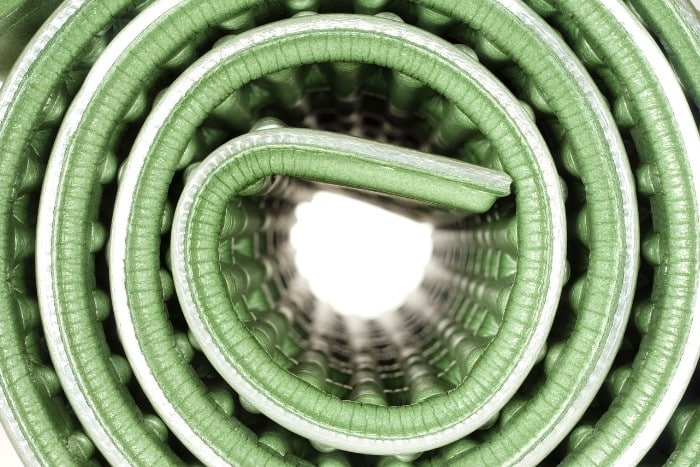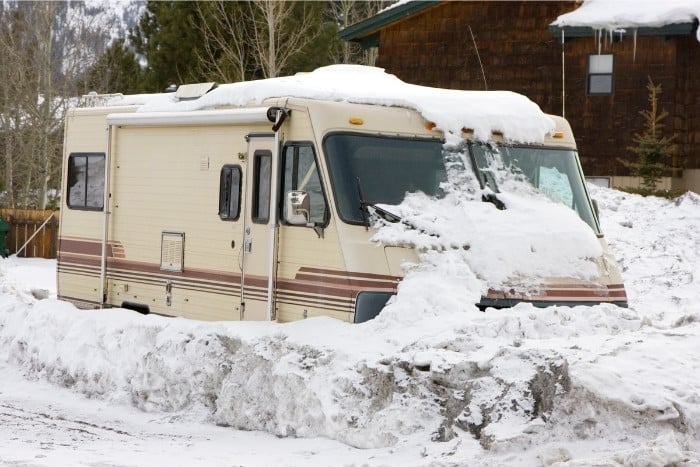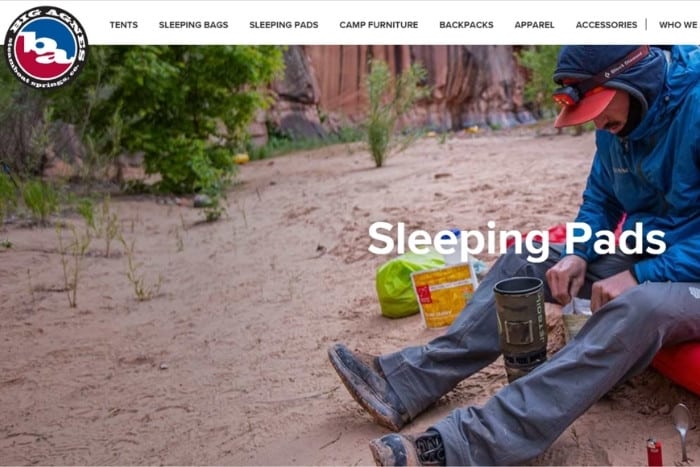While browsing products for your next cold-weather camping trip, you may have encountered the term R-value. What is it, and why is knowing what it means critical to a warm and safe night’s sleep when the weather outside is freezing?
The R-value measures how effectively a two-dimensional barrier, like a sleeping pad, prevents the conductive flow of heat. In terms of winter camping equipment, knowing which R-value to choose can be the difference between a warm night’s sleep and a potentially dangerous medical situation.
Sleeping bags show their warmth in GSM (Grams per Square Meter) or their insulative properties using TOG (Thermal Overall Grade). On the other hand, sleeping pads – the layer you place between your sleeping bag and the ground – use the R-Value to indicate which seasons they may be appropriate for.
R-Value of Sleeping Pads for Winter Camping
Below, we’ll take a closer look at the R-value of a sleeping pad, why it’s important, how it’s calculated, and what else you may want to factor in before making your final choice.
Most importantly, we’ll also show you which sleeping pad brands you can trust the most in terms of quality and which pads we recommend based on your specific needs.
1. What Does R-Value Mean?
Simply put, a sleeping pad’s R-value is the thermal insulation level the pad provides. The higher the R-value, the less body heat transferred to the cold ground during the night. If you’re camping during winter, limiting the amount of body heat you lose while you sleep is extremely important.
Until recently, there was no international standardization for the thermal resistance of sleeping pads, meaning different brands used different units to describe their products.
This meant that one company’s R-value could be completely different from another’s, making it difficult to choose the right pad if changing brands.
Furthermore, some companies didn’t even use the R-value as a measurement, opting to provide temperature ratings instead, making it even harder to choose between products.
Fortunately, in 2020, a conglomerate of major camping equipment manufacturers lobbied for standardization with ASTM International (American Society for Testing and Materials), which introduced the ASTM F3340-18 standard to allow consumers to make direct comparisons between insulating ground pads.

2. How is the R-Value Calculated?
With the standardization of the R-value across brands came the standardization of the testing method used to calculate the thermal resistance to heat loss of sleeping pads.
To calculate the R-Value to the ASTM standard, a sleeping pad is sandwiched between a hot plate sitting at 35 degrees Celsius (95 degrees Fahrenheit) and a cold plate at 5 degrees Celsius (41 degrees Fahrenheit).
The purpose of the hot plate is to mimic a human body, and the cold plate is the stand-in for the cold ground.
These temperatures are maintained using a stable electric current.
Furthermore, this testing apparatus takes place in a thermally-sealed cold chamber which maintains a temperature of 4 degrees Celsius (39 degrees Fahrenheit) throughout the experiment.
Over four hours, sensors measure the energy needed to maintain the hot plate’s temperature.
This figure is then plugged into an equation to give us the R-value of the pad.
Essentially, the more energy required to keep the hot plate at the correct temperature, the lower the R-value; the less energy required, the higher the R-value.
3. Why is the R-Value Important For Winter Camping?
The R-value of a sleeping pad is extremely important for winter camping as choosing the wrong equipment at this time of year can yield dangerous consequences. In warmer months, losing body heat during the night might, at worst, result in poor sleep and a few morning aches. In winter, however, there’s a real risk of hypothermia.
Hypothermia can be deadly if untreated by medical professionals and results in your body producing heat at a lower rate than when it’s losing it.
Our regular body temperature sits around 37 degrees Celsius (97 degrees Fahrenheit), and it only takes a two-degree Celsius drop for hypothermia to kick in.
Importantly, our bodies lose heat in numerous ways, including conduction, evaporation, and radiation, so it’s crucial to keep all of these in check when winter camping on the potentially freezing ground.
4. What R-Value Do I Need For Winter Camping?
Recommendations for R-values based on the season may not be the best, as the air and ground temperature during a particular season can vary wildly based on your location.
Therefore, using a guide based on air temperature is better to gauge which R-value is best for you.
Typically, for air temperatures of 10C (50F), an R-value of 1.0 should be sufficient.
Any sleeping pad with an R-value below 1.0 should generally be considered a layer used to provide a level of comfort rather than any thermal protection.
If the air temperature is around 0C (32F) and -18C (0F), you’ll need to choose a pad with an R-value in the 2.5 – 5.0 range.
Below 30C (-21F), you’ll want something with at least a 6.5 R-value.
R-values can reach into the low double-digits for the highest insulation levels, but even these suggestions are a rough guide, as there are other factors to bear in mind when choosing a sleeping pad.
Other Factors to Consider
Instead of simply checking a season or temperature guide to decide which R-value is the right one for your winter camping trip, you’ll want to look at the factors listed below that can affect the type of sleeping pad you pick.
1. R-Values Are Additive
This means you can combine sleeping pads and add their R-values together to get the new total R-value.
In reality, you’re likely to see a small drop in the R-value due to heat transference between the layers.
Still, you can minimize this thermal insulation loss by ensuring as little air between the two layers as possible.
Pairing layers can be useful if you have a less-durable top pad that you want to protect with a tougher ground mat with a lower R-value.
2. Male or Female
While it’s worth noting that this factor won’t be the same for everyone, men generally have a higher body mass than women, which means they lose heat slower.
For women and people who tend to be “cold sleepers,” you’ll likely want to add 1.0 to the suggested R-value for your camping trip.
3. Type of Ground
When choosing an R-Value for your sleeping pad, think about the type of ground you’ll be sleeping on at night.
Counterintuitively, snow is a poor conductor of heat and can pull less body heat away than freezing ground with no snow cover.
You may also want a sleeping pad with a higher R-value if you’re sleeping in a car or campervan rather than a tent.
Tent materials are usually much better at preventing heat loss than metal vehicles with much greater thermal conductors and therefore become cold far more quickly.

4. How Do You Sleep?
Choosing the right sleeping pad can also depend on how you sleep at night.
If you sleep on your back or front, the surface area of your body will be spread evenly across the bottom of your sleeping bag and the top of your sleeping pad.
If you sleep on your side, your weight will be concentrated over a smaller surface area, so if your pad is thinner, there’s an increased chance your body will compress the material to a point touching the ground.
If this occurs, you’ll negate most of the thermally resistant properties of the sleeping pad, meaning the real R-value will be lower than stated in the product description.
Therefore, side-sleepers will want a thicker pad.
5. Other Factors
Lastly, there are a handful of other things to remember when picking a sleeping pad that has little or no bearing on which R-value you choose but are equally important.
If you’re a light sleeper with a propensity to toss and turn at night, some sleeping pads are more prone to making noise when you move on top of them, so you’ll want to contemplate this when making your choice of pad.
Suppose you’re planning an active backpacking trip that involves wild camping or hiking between sleeping spots.
In that case, there’s no point in choosing a thick, heavy sleeping pad, especially something that requires manually inflating before each use.
You’ll also want to factor in the size and shape of your sleeping bag, as your pad of choice will need to cover all the ground between your bag and the ground.
Both sleeping pads and bags come in different shapes and sizes, and there’s little advantage to using a pad if your feet touch the cold ground.
What Sleeping Pad Brand Should You Choose?
Before we look at specific products below, we’ll cover the core sleeping pad brands that are guaranteed to strictly adhere to the international standard for R-values.
Many of these suppliers had gone as far as back-testing all of their products manufactured before the international standard came into place to calculate the new R-value.
Some of these companies even brought the international standard into use in the first place. You can be assured of their commitment to transparency and quality.
1. Therm-a-Rest
Initially formed by a pair of ex-Boeing engineers fifty years ago, Seattle-based Therm-a-Rest is renowned for inventing the first self-inflating sleeping pad.
One of the first proponents of an international standard for the R-value, Therm-a-Rest is currently the only manufacturer with its cold chamber and testing apparatus, with other companies outsourcing the task.
2. NEMO
NEMO Equipment was founded off the back of its founder spending a sleepless night camping two decades ago.
Three days after Cam Brensinger graduated from the Rhode Island School of Design, he opened the company’s first office in New Hampshire.
NEMO’s dedication to cutting-edge design has even landed them partnerships with the NASA Institute for Advanced Concepts in the field of shelter architecture for interstellar exploration.
3. Sea to Summit
Sea-to-Summit began as a collaboration between Tim Macartney-Snape, the first Australian to summit Mount Everest, and his country-mate, friend, and climbing partner, Roland Tyson, who designed much of the former’s equipment.
The name Sea to Summit refers to Macartney-Snape’s second Everest expedition, where he preceded his climb with a 700-mile trek from the Bay of Bengal and through India, rather than the usual base camp start at 17,958 feet.
4. REI
Another brand to push for an international standard for the R-value, REI (Recreational Equipment, Inc.), is also headquartered in Seattle and has been operating as a cooperative provider of mountaineering and camping gear since 1938.
In 1963, their CEO, Jim Whitaker, became the first American to summit Mount Everest, demonstrating their products’ quality, and consumer interest in their products exploded.
5. Big Agnes
Big Agnes was formed twenty years ago in the Colorado ski town of Steamboat Springs to produce gear suitable for wild camping in the mountainous backcountry.
Their location means they have a lot of experience designing equipment for winter camping and inclement weather conditions.

Which Sleeping Pad is Best For You?
As we mentioned earlier, there are several things to factor in before settling on your choice of the sleeping pad for winter camping, alongside its R-value.
Here, we’d like to give you a list of our recommendations to make it easier to figure out which choice to make based on your specific needs.
1. Best For Sub-Zero Temperatures
For winter camping in the coldest temperatures, you can’t beat the NeoAir® XTherm™ Sleeping Pad by Therm-a-Rest.
While it may sit at the higher end of the price scale, this inflatable sleeping pad boasts a whopping 6.9 R-value.
With a packed weight of just 17oz and packed dimensions of only 9×4″, it offers the best warmth to weight ratio around.
2. Best For All-Seasons
With an R-rating of 4.0, the Sea to Summit Comfort Plus is our pick for a sleeping pad that provides enough insulation to keep you warm in all but the coldest temperatures but not so warm that you can’t use it at any other time of the year.
It’s also one of the most comfortable pads on the market due to its two-layered construction.
3. Best for Side-Sleepers
If you tend to sleep on your side and require a little extra thickness from your sleeping pad, the NEMO Tensor Insulated offers 3 inches of ground clearance and an R-value of 4.2.
This makes it ideal for winter camping and eliminates the risk of your body compressing it to the point of affecting its thermal resistivity.
4. Best for Hikers
The Therm-a-Rest Prolite Apex is an ultralight, self-inflating sleeping pad that eliminates the need for a pump and offers rapid inflation along with a 3.8 R-value.
Weighing in at a mere 20oz, this pad is ideal for long winter hiking trips through the backcountry.
However, the weight reduction comes at the cost of the pad being unsuitable for the coldest temperatures.
Conclusion
Now you know what an R-value is in terms of sleeping pads and which brands offer the best products, you should find it much easier to identify which will best suit your needs.
Most importantly, you’ll be able to guarantee a warm, comfortable, and safe night’s sleep while winter camping, regardless of how cold the temperature might be outside.
